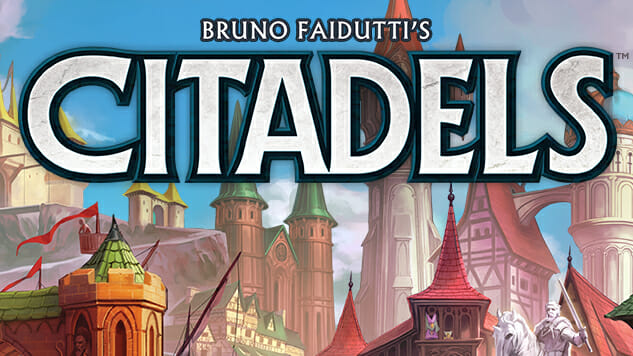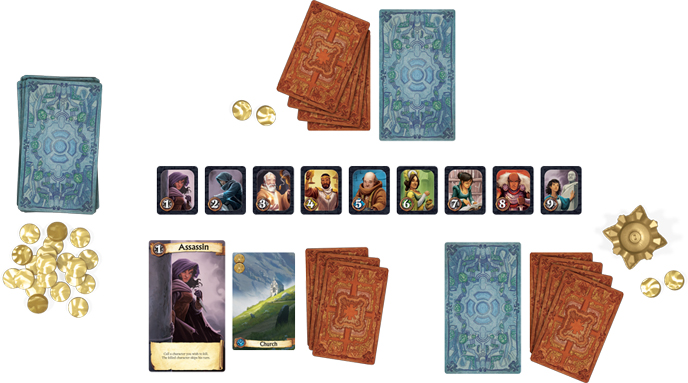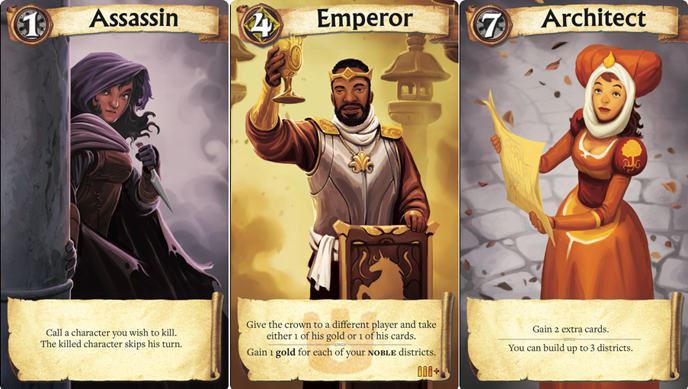
Bruno Faidutti’s 2000 title Citadels is one of the few good boardgames on the market that works well for more than four players. In fact, I’d argue it requires at least four for the best experience. Asmodee has brought it back out in a new ‘big box’ edition that includes all of the original cards and tokens, the later Dark City expansion, and several new pieces that all give the game a ton of replayability.
The basic mechanics of Citadels couldn’t be much simpler. Each round, every player chooses a character (role) to play for that one round, and on a turn, the player can either take gold or draw a new building card, pay and build one of those cards if desired, and may use the character’s special ability, if applicable. When one player constructs his/her seventh building (or eighth if there are fewer than four players), that triggers game-end; the players complete the current round and score points. Each building is worth one point per coin it cost to build, and there are bonuses for finishing first, for building one of each of the five building types, and for some of the buildings themselves.
The game’s “catch” is in interactions between the characters. Players select roles via a mechanic later popularized by 7 Wonders; the start player shuffles the eight role cards, discards a number specific to the number of players, chooses one of the remainder, and passes to his/her left. That player chooses one, passes it along, and so on, until the final player gets to choose from two cards and places the last one face-down on the table, so only s/he knows what’s there, and nobody knows for sure what role any other player is.
Each character has a number from 1 to 8 (there are a few characters numbered 9 for certain player counts), and the characters’ roles are called in order, starting at 1. The base game’s characters begin with the Assassin (1), who calls out another character to ‘kill’ for that round – not the player, mind you, but the character, so it’s a bit of guesswork involved if you want to target the leader – and the Thief (2), who robs another character in similar fashion. The Warlord (8) can destroy another player’s building, but not one of the Bishop’s (5), while both players as well as the King (4) and Merchant (6) get extra gold if the player has buildings of the matching color. The Magician (3) can steal your cards, and the Architect (7) gets to draw two cards as a bonus, and is the only role of the eight that can build multiple building cards on a turn.
Additional roles from the expansion and the new edition follow similar patterns to the base roles, so other 1 cards also severely limit another’s players turn, other 5 cards reward you for religious “districts” (the game’s term for building cards), other 7 cards let you gather more cards in addition to gold, and so on. The new manual includes six suggested combinations of characters and unique district cards to use in the deck, although you can create any combination you’d like.
With two or three players, Citadels alters the role allocation process so that each player takes two characters per round, but still maintains one stash of gold, one hand of district cards, and one set of buildings in front of them. It works, but fundamentally alters your strategy because you can plan in your first role to do something, like building a very high-value district card, in your second role.
The one negative of Citadels is that with higher player counts, there’s going to be a fair amount of downtime between turns. Each individual turn should be fairly quick, but with seven or eight players, those will still add up to enough time to go complain on Twitter about how long the Cardinal is taking to finish her turn. And if you happen to be the Assassin’s target, which means you lose your entire turn – you’re not even supposed to respond when your role is called – then you could go quite a long time between moves.
Asmodee released two new versions of Citadels in the fall. One is just called Citadels and comes in a big box with the above-mentioned expansions, some rules changes for specific cards, and brand-new art throughout. The second is called Citadels Classic and includes the original game with some of the older artwork, available in a smaller box for about half the price of the new one; I haven’t seen this version so I can’t compare them, but I do like that the updated version offers at least three different roles for each number, so you can truly customize the game as you wish and won’t get bored with the same old octet every time.
Keith Law is a senior baseball writer for ESPN.com and an analyst on ESPN’s Baseball Tonight. You can read his baseball content at search.espn.go.com/keith-law and his personal blog the dish, covering games, literature, and more, at meadowparty.com/blog.

